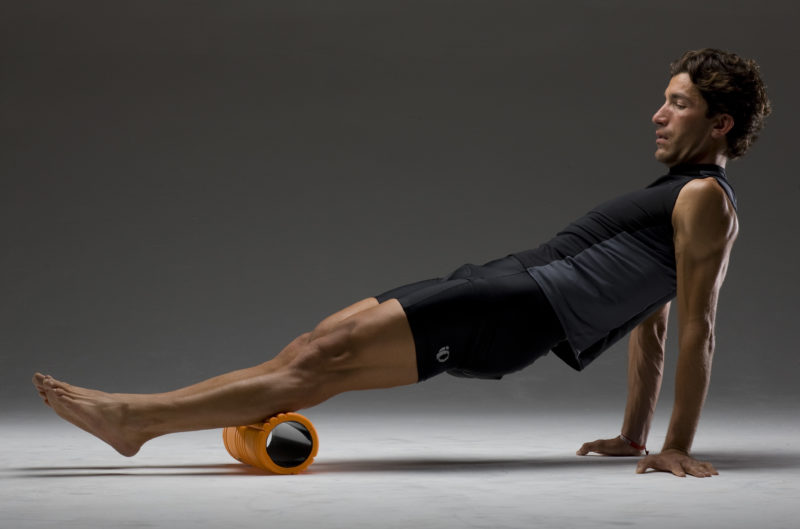One of the important additions to my workout and fitness routines this year was the incorporation of a foam roller. I like to foam roll first thing in the morning after drinking my espresso and doing a 10-15 minute meditation.
Here’s a quick taster of what foam rolling can do:
- Release trigger points and tight muscles, tendons and ligaments
- Increase blood flow through your skin, fascia and muscles, thereby improving tissue quality and cellular function
- Engage core muscles and build strength
- Increase range of motion in your spine
- Improve posture by strengthening your core
When foam rolling you are aiming for a myofascial release. The myofascial system is made up of all the muscles and fascia in your body. A fascia is a band or sheet of connective tissue, primarily collagen, beneath the skin that attaches, stabilizes, encloses, and separates muscles and other internal organs.
For those of you who are visual learners, you can imagine your skin is like the rind of an orange. So, if your skin is the outer layer of the orange peel, the thicker, white, fibrous layer that lies almost immediately beneath the peel would be your fascia. Just as that thicker layer completely surrounds the inside of the orange, the same holds true to your fascia. We all have a layer of fascia directly beneath the skin that completely envelopes the body, giving another protective barrier between the skin and the deeper soft tissue.
For various reasons, including inactivity, repetitive motion and injuries, the fascia and underlying muscle tissue can bind together causing painful ‘knots’ or ‘trigger points’. Muscle binding will restrict movement, reduce flexibility and cause muscles to fire improperly during exercise.
Rolling out stretches muscles and tendons and releases the fascia. This increases blood flow and circulation to the soft tissues, allowing muscles to fire at peak efficiency during exercise.
When rolling or working on tight/sore muscles you will experience discomfort or pain. Think of it like the pain you get while stretching. It should be uncomfortable, but not unbearable, and when you are done it should feel better.
Studies have shown that people who use foam rollers for self-myofascial release experience a significant increase in range of motion (ROM). You will find several testimonials on the web (here’s one) from people who tried foam rolling regularly and achieved similar results.
I am using the acclaimed TriggerPoint GRID foam roller, which you can easily get off Amazon.
Here it is in action, together with an explanation of what foam rolling is and why you should be doing it.
I’ve curated a few excellent videos that are great to get you started with this practice, which you’ll find at the end of this post.
Before we get to that, a few important notes on technique and frequency.
You should roll slowly, no more than one inch per second. When you find areas that are tight or painful, pause for several seconds and relax as much as possible. You should slowly start to feel the muscle releasing, and after 5-30 seconds the discomfort or pain should lessen.
If an area is too painful to apply direct pressure, shift the roller and apply pressure on the surrounding area and gradually work to loosen the entire area. The goal is to restore healthy muscles – it is not a pain tolerance test.
You may be sore the day after foam rolling. It should feel as if your muscles have been worked/released, however, you should not push yourself to the point of excessive soreness. Drink plenty of water, get enough sleep, and eat clean. This will help to flush your system and fuel your muscles more effectively. Give it 24-48 hours before focusing on the same area again.
It’s important to do the exercises correctly or you’ll end up doing more harm than good.
Remember to work your way up from the bottom to the top of your body. It’s totally fine to focus on specific areas only on particular days of the week. Another key to foam rolling is to do it regularly, say 3-5 days a week.
The good thing is that it doesn’t take an exorbitant amount of time, and while it may sometimes hurt, it will leave you feeling much better in the end. With time you will, of course, start to notice the benefits that we’re ultimately looking for: better flexibility and mobility, faster recovery.
OK, let’s watch some videos to get a better idea of how to foam roll.
The first video I suggest is an introduction to foam rolling, including some essential NOT TO DO tips:
Another great video explaining the theory behind foam rolling and important things to watch out for:
A nice full-body workout:
Yoga poses combined with foam rolling:
Full playlist with excellent foam rolling exercises for the whole body:
Some further resources:
- Put away the foam rollers and massage balls. Loosen your tight IT band with these yoga poses and stretches instead.
- How to Use a Foam Roller – Applied Movement Neurology
- What Is a Foam Roller, How Do I Use It, and Why Does It Hurt? | Breaking Muscle
What are your experiences with foam rolling? Let me know in the comments section below.

